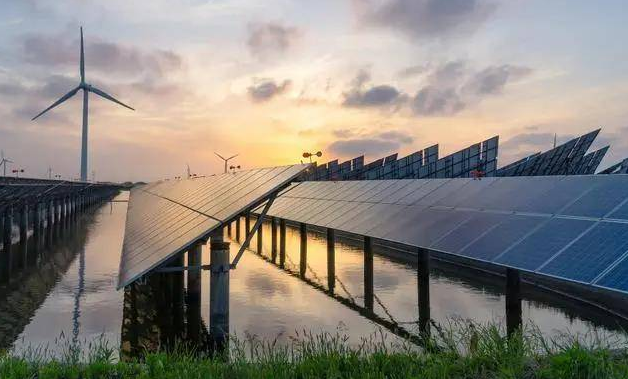On the eve of new energy technology breakthrough, are we ready
Wind, solar, biomass... Which new energy is most favored by the scientific and technological community?
Hydrogen energy will be an important medium to build the future energy system and achieve energy reform, and the breakthrough of solar fuel technology and its cost reduction will rapidly reduce the dependence on fossil fuels
Guo Jianfeng, a researcher at the Strategic Advisory Institute of Science and Technology of the Chinese Academy of Sciences, said that through the analysis of published papers, new energy technologies are in a period of accelerated development, and the number of published documents in seven technical fields, such as solar energy, wind energy and hydrogen energy, in addition to nuclear energy, exceeded 40% of the total in the past 20 years from 2015 to 2019, of which five fields exceeded more than half. Further focusing on the publication situation from 2015 to 2019, it was found that the global attention to new energy continued to rise, and a total of 388,416 papers were published in the field of new energy during the five-year period, with a compound annual growth rate of about 10%.
Guo Jianfeng introduced that the statistics of the top 10 most frequently cited papers can reveal the research directions of different new energy technologies in the world: biomass energy research mainly focuses on lignin pyrolysis, catalysts, pretreatment, microalgae biofuels, biorefining and other directions; Energy storage research mainly focuses on lithium-ion batteries, sodium-ion batteries, lithium-sulfur batteries, positive and negative electrode materials, fast charge technology and other directions; Geothermal energy research focuses on enhanced geothermal systems (EGS), numerical simulation of geothermal systems, and geothermal drilling technology. Research on hydrogen energy mainly focuses on non-precious metal catalysts, metal-organic framework materials, cobalt-based catalysts, bifunctional catalysts, etc. The main concerns of nuclear energy research include nuclear waste disposal technology, nuclear power plant safety technology, radiation resistant materials, magnetic confinement nuclear fusion, inertial confinement nuclear fusion, etc. Solar energy research focuses on perovskite solar cells, laminated solar cells, solar photocatalytic hydrogen production, catalysts, semiconductor electrodes, etc. Energy Internet research focuses on smart energy systems, big data, smart home energy management systems, demand response and other directions; The main focus of wind energy research includes high power energy converter, wind turbine, wind power numerical simulation, wind power high proportion stable grid connection, etc.
In these fields, both paper statistics and scientist interviews have found that hydrogen energy and solar energy are the two new energy sources that we focus on.
In the future energy system, hydrogen energy is an important secondary energy source for carbon reduction, and the research heat of hydrogen production, hydrogen storage, and hydrogen energy transportation and utilization is growing rapidly. Among them, the hydrogen fuel cell or hydrogen engine that has received the first attention can change the traditional means of transportation and solve the problem of urban air pollution and decarbonization caused by transportation fuel consumption. In the process of the rapid increase in the scale of renewable energy power generation, the absorption capacity of the power grid is one of the bottlenecks, and the flexible absorption of wind and light through electrolytic water hydrogen production provides a new path to solve the problem that the scale of photovoltaic and wind power is limited by the consumption side demand and the absorption capacity of the power grid. At the same time, hydrogen production from renewable energy sources will also become a sustainable source of green hydrogen in the future.

Hydrogen energy is an important entry point to promote the deep decarbonization of the energy system. Since 2018, many countries, including Japan, South Korea, Australia, the United Kingdom, and France, have released the latest plans in the field of hydrogen energy. Japan has made it clear that by 2025, it will fully popularize hydrogen transportation, expand the application of hydrogen energy in power generation, industry and households, and by 2030, the cost of hydrogen energy use will be no higher than that of traditional energy. The EU Hydrogen Strategy, published in July 2020, proposes a "strategic roadmap for building a hydrogen ecosystem in Europe to 2050", with the goal of rapidly reducing carbon emissions from hydrogen production and developing other forms of low-carbon hydrocarbon to support the transition to renewable hydrogen production before 2030. China is more active in the research and development of key technologies for hydrogen energy. China's earliest hydrogen energy development deployment is to list hydrogen fuel cell vehicles as one of the development directions of new energy vehicles. However, due to the high cost of hydrogen production technology and hydrogen fuel cells and the layout of hydrogen refueling stations and other problems restricting the development of the industry, compared with pure electric vehicles and hybrid electric vehicles, hydrogen fuel cell vehicles are still in the demonstration operation stage. In response, China's research activity in key links such as hydrogen production, hydrogen storage and hydrogenation also ranks at the forefront of the field of new energy.
- EMERSON
- Honeywell
- CTI
- Rolls-Royce
- General Electric
- Woodward
- Yaskawa
- xYCOM
- Motorola
- Siemens
- Rockwell
- ABB
- B&R
- HIMA
- Construction site
- electricity
- Automobile market
- PLC
- DCS
- Motor drivers
- VSD
- Implications
- cement
- CO2
- CEM
- methane
- Artificial intelligence
- Titanic
- Solar energy
- Hydrogen fuel cell
- Hydrogen and fuel cells
- Hydrogen and oxygen fuel cells
- tyre
- Chemical fiber
- dynamo
- corpuscle
- Pulp and paper
- printing
- fossil
- FANUC
- Food and beverage
- Life science
- Sewage treatment
- Personal care
- electricity
- boats
- infrastructure
- Automobile industry
- metallurgy
- Nuclear power generation
- Geothermal power generation
- Water and wastewater
- Infrastructure construction
- Mine hazard
- steel
- papermaking
- Natural gas industry
- Infrastructure construction
- Power and energy
- Rubber and plastic
- Renewable energy
- pharmacy
- mining
- Plastic industry
- Schneider
- Kongsberg
- NI
- Wind energy
- International petroleum
- International new energy network
- gas
- WATLOW
- ProSoft
- SEW
- wind
- ADVANCED
- Reliance
- YOKOGAWA
- TRICONEX
- FOXBORO
- METSO
- MAN
- Advantest
- ADVANCED
- ALSTOM
- Control Wave
- AB
- AMAT
- STUDER
- KONGSBERG
- MOTOROLA
- DANAHER MOTION
- Bently
- Galil
- EATON
- MOLEX
- Triconex
- DEIF
- B&W
- ZYGO
- Aerotech
- DANFOSS
- KOLLMORGEN
- Beijer
- Endress+Hauser
- MOOG
- KB


Email:wang@kongjiangauto.com
























































































